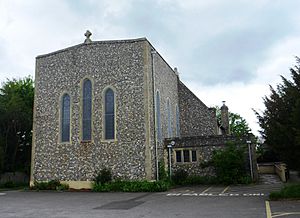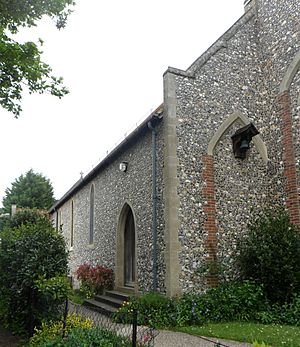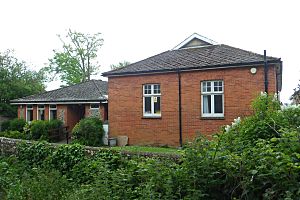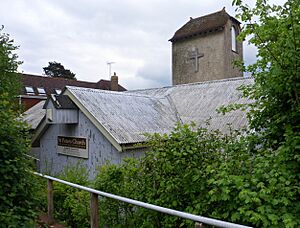St Symphorian's Church, Durrington facts for kids
Quick facts for kids St Symphorian's Church |
|
|---|---|

The church from the east
|
|
| 50°50′11″N 0°24′48″W / 50.8364°N 0.4133°W | |
| Location | Durrington Hill, Durrington, Worthing, West Sussex BN13 3HU |
| Country | England |
| Denomination | Anglican |
| Churchmanship | Modern Catholic |
| Website | www.stsymphorians.co.uk |
| History | |
| Status | Parish church |
| Founded | 10th/11th century (original church); 1890 (temporary replacement chapel); 1914 (present church) |
| Dedication | Symphorian |
| Dedicated | 13 October 1915 |
| Consecrated | 15 December 1916 |
| Architecture | |
| Functional status | Active |
| Heritage designation | Grade II |
| Designated | 11 October 1949 |
| Architect(s) | Lacy W. Ridge; W.H. Godfrey |
| Style | Early English Gothic Revival |
| Groundbreaking | 1914 (present church) |
| Completed | 1941 |
| Administration | |
| Parish | Durrington |
| Deanery | Rural Deanery of Worthing |
| Archdeaconry | Chichester |
| Diocese | Diocese of Chichester |
| Province | Canterbury |
St Symphorian's Church is an Anglican church in the Durrington area of Worthing, a town in West Sussex, England. The church has a long and dramatic history. The first church on this site was built in the 13th century but fell into ruins after being damaged during the English Civil War.
For many years, the village had no church. As Durrington grew into a suburb of Worthing, a temporary church was set up in 1890. The permanent church you see today was built during World War I and finished during World War II. Because of its special history and architecture, it is a Grade II listed building.
Contents
History of the Church
The First Church
The village of Durrington has existed since at least 934, during the time of the Saxons. The Domesday Book of 1086, a great survey of England, mentioned that Durrington had a church. The first church was likely a simple building made of plaster, woven sticks (called wattle and daub), and a thatched roof.
Later, a stronger stone church was built. It had a main hall called a nave and a special area at the front called a chancel. A large cross stood on a screen between these two parts. The church also had a stone pulpit for preaching and a stone font for baptisms.
This church was a chapelry of a larger church in the nearby village of West Tarring. This meant it was looked after by priests from Tarring, and most of the local taxes, called tithes, went to the Tarring church.
A Church Divided and Ruined
In the 1640s, the English Civil War broke out. This was a conflict between the supporters of King Charles I (the Royalists) and the supporters of Parliament (the Parliamentarians). The priest of Tarring, Reverend William Stanley, was a strong Royalist. However, most of the people in Durrington supported Parliament.
The villagers were already unhappy with Reverend Stanley. They found his sermons hard to understand and felt he didn't do his duties. When he joined the king's army in 1641, the villagers became very angry. In 1643, during fighting in Sussex, they took out their anger by partly destroying their own church.
After the war, the church was left in ruins. By 1677, it was in such bad shape that a church court asked the villagers why it hadn't been repaired. The villagers explained that it was ruined during the war and they were too poor to fix it.
Around the same time, the churchwarden admitted to selling the church bell to raise money for the poor. The villagers were given permission to abandon the ruined building and worship at the church in West Tarring instead. The old church slowly crumbled away, and some of its stones were even used to build new houses.
A New Beginning
For a long time, Durrington was a quiet, rural area. But in the late 19th century, it began to grow as the nearby town of Worthing became more popular. The land was also great for market gardening, so many farms were set up.
In 1890, a new priest paid for a small, temporary chapel to be built in the grounds of the old ruined church. This type of building was often called a tin tabernacle because it was made of corrugated iron. This meant villagers could attend services in Durrington again.
Soon, people wanted a permanent church. In 1911, a committee was formed to raise money. A local architect named Lacy W. Ridge was chosen to design the new building.
Building the Modern Church
Work on the new church began in 1914, just as World War I started. The builders cleverly used the remaining walls of the old 13th-century church in the new structure. Despite the challenges of the war, the church was ready to open in 1915. It was dedicated to St Symphorian, a Christian saint.
Durrington continued to grow, and the church needed to be bigger. In 1941, during World War II, a new chancel was added by the architect W.H. Godfrey, completing the building. The first part of the church cost £1,735 in 1915, and the extension cost £4,509 in 1941.
Architecture and Design
St Symphorian's Church is built in a style called Early English Gothic. It is made from flint, a type of local stone, with lighter stone used for the corners and window frames.
Inside, the church has a wide main hall (the nave) and a taller chancel at the front. You can still see parts of the original 13th-century walls inside the church. A small piece of the even older Saxon church has also been found in the north wall. A medieval stone basin called a piscina, which was saved from the ruins, is now on the east wall.
The wooden roof of the nave is considered a special feature of the church. Most of the windows are tall and pointed, which is typical of the Gothic style. Some windows have beautiful stained glass, including one that remembers the victims of the World Wars.
St Peter's Church in High Salvington
As more people moved to the High Salvington area, north of Durrington, a small mission chapel was opened there. This church, dedicated to Saint Peter, is a tin tabernacle, a type of iron church that is now very rare in Britain. It is the only one left in Worthing.
For many years, St Peter's was part of St Symphorian's parish. In 2010, it became part of the Parish of All Saints Church in Findon Valley.
The Church Today
St Symphorian's Church is an active parish church. It holds regular services, including a main service every Sunday and daily prayer sessions.
The church is a "nationally important" building of "special interest," which is why it is protected as a Grade II listed building. It stands as a reminder of Durrington's long history, from a small Saxon village to a busy modern suburb.
See also
- Listed buildings in Worthing
- List of places of worship in Worthing




